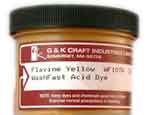I am looking for a dye that will work on sea shells
I am looking for a dye that will work on sea shells
Name: Loretta
—ADVERTISEMENTS—
Washfast Acid dyes
at Paradise Fibers

Washfast Acid dyes
Also known as Nylomine dyes, excellent for use on nylon and on any protein-containing fiber, such as wool.
at Paradise Fibers

Washfast Acid dyes
Also known as Nylomine dyes, excellent for use on nylon and on any protein-containing fiber, such as wool.
Country or region: USA
Message: Lisa White Reber from DippyDyes gave me your name. I am looking for a dye that will work on sea shells. Years ago they used a dye and the shells looked great, that dye has been banned. I do volunteer work for our community in Florida and we dye shells to make flowers. I know there are some shells you cannot dye, but there are many you can. Do you know of any dye I can use, I am willing to experiment. Thank you for your time, any information you can give me will be gratefully accepted.
I'm glad that you are willing to experiment, because I have no personal experience with dyeing shells.
Seashells are made primarily of calcium carbonate, with perhaps 10% of the total being a protein matrix that is produced by the shellfish. To color the proteins, you would use an acid dye. There are thousands of different acid dyes in the world. The easiest to find in a hurry would be food coloring; most food colorings are acid dyes, and, though they do not perform as well as the best textile dyes, they do perform surprisingly well.
The normal technique is to mix the food coloring with water and a bit of vinegar, then heat the item to be dyed in this dyebath, on the stovetop, to nearly boiling if the heat does not damage the shells. Maintain the dyebath at a simmer for a while, perhaps fifteen minutes or an hour, then allow the dyebath to cool, and rinse the excess dye off the shells.
(Be careful not to expose the shells to too high a concentration of vinegar, or for too long a time peroid. Don't leave your shells soaking in vinegar overnight without testing to be sure that this does not damage them. In assessing the results of your tests, check carefully to see whether the acid has removed too much of the sheen of the sea shells. A little bit of acid aids the dye in bonding to the proteins, but an excess may cause damage to the shells' surface.)
An even simpler technique using grocery-store materials is to buy Kool-Aid or another drink mix that is sold in unsweetened form. They consist of acid dyes, artificial flavoring, and citric acid; the presence of the citric acid means that you do not need to add vinegar. Experiment to see how much drink mix powder you need to use to get a certain color.
If the food colorings turn out to be entirely satisfactory, then you will have an additional selling point to put on your labels, indicating that they are completely safe even for use by children (except for the obvious issues of choking hazards). However, as a general rule, dyes made specifically for textiles tend to be more satisfactory for non-food purposes, because they are more resistant to fading from light or from washing. You could consider using ProChem's Washfact Acid Dyes, or Jacquard Acid Dyes, or Dharma's new acid dyes, or Lanaset dyes, or any other sort of dye that is sold for use on wool. Wool is almost always dyed only with acid dyes. All-purpose dyes, such as Rit, do contain some acid dyes (as well as another type of dye), but they are usually not as satisfactory as other acid dyes; however, they are very easy to find, even in grocery stores and pharmacies, which may make them worth a try.
Some people have used Procion MX fiber reactive dyes, the type of dye found in all of the best tie-dyeing kits (though not the Rit brand tie-dyeing kit), with soda ash rather than vinegar, to dye shell buttons. It would be worth a small experiment, if you have any of this sort of dye on hand.
Alternatively, you might prefer to use a paint, rather than a true dye. One of the thinner paints that is intended to imitate a dye would be a good choice, such as Dye-Na-Flow or SetaColor. Since these fabric paints are very thin, they will give an effect similar to that of dye. You could also try diluting ordinary artists' acrylic paints with water to thin them enough for a similar effect.
Please let me know the results of your tests. I hope that you will be able to find a dye or a paint that is easy to use and produces the effects that you want.
(Please help support this web site. Thank you.)
Posted: Monday - September 27, 2010 at 07:41 AM
Follow this blog on twitter here.
Quick Links
- All About Dyes & Dyeing Top -
- Top of this blog -
- FAQ -
- The Dye Forum -
- How to Tie Dye - How to Batik -
- Books - Toys - Plants -
- Top of this blog -
- FAQ -
- The Dye Forum -
- How to Tie Dye - How to Batik -
- Books - Toys - Plants -
More in this category:
- -
Statistics
Total entries in this blog:
Total entries in this category:
Published On: Aug 29, 2012 02:49 PM
Total entries in this category:
Published On: Aug 29, 2012 02:49 PM